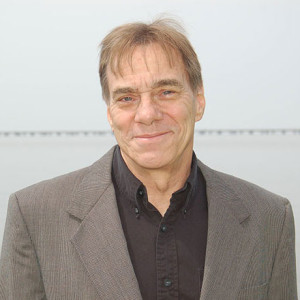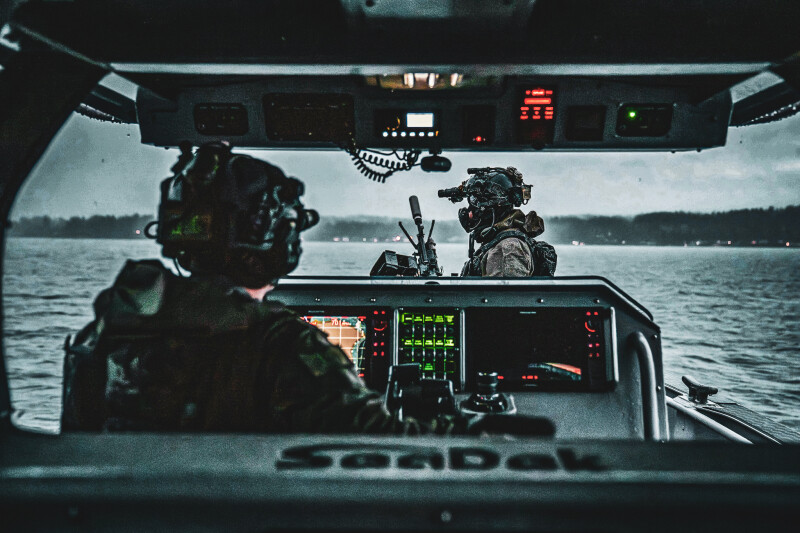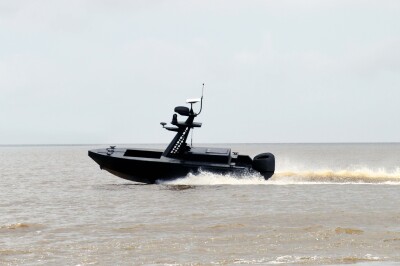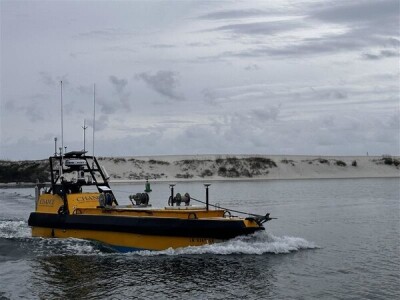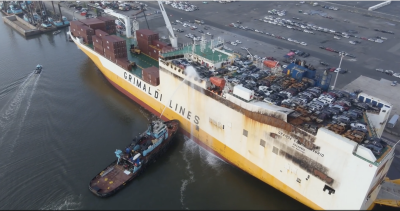The words patrol boat are straightforward in their meaning. Military patrol boats do exactly what the name says. They look out for the entities and interests of the countries who own them, protecting them from those who wish to do them harm. They are normally used for border security, coastal defense, and law enforcement.
“We define patrol boats by their application by the end user. Typically, patrol boats are designed for longer missions and often have additional features to enhance habitability and crew comfort,” said Rob Goley, director, business development and strategy, SAFE Boats International, Bremerton, Wash. “In the United States, patrol boats are often 40' to 120' in length. However, our international customers may use boats as small as 25' or 30' for extended patrol missions.”
There are shipyards in the U.S. like SAFE Boats that build patrol boats for the U.S. Department of Defense and for foreign governments through the U.S. Foreign Military Sales (FMS) program. FMS is a form of security assistance authorized by the Arms Export Control Act (AECA) and a tool of U.S. foreign policy. Under Section 3 of the AECA, the U.S. may sell defense articles and services to foreign countries and international organizations when the president of the United States formally finds that to do so will strengthen the security of the U.S. and promote world peace.
.jpg.medium.800x800.jpg)
FMS PROGRAM
Under FMS, the U.S. government and a foreign government enter into a government-to-government agreement called a Letter of Offer and Acceptance. The secretary of state determines which countries can participate, and the secretary of defense executes the program through the Defense Security Cooperation Agency (DSCA).
DSCA’s mission is “advancing U.S. defense and foreign policy interests by building the capacity of foreign partners in order to encourage and enable allies and partners to respond to shared challenges,” according to its website.
The program has been a financial boon for some Tier II U.S. shipyards. Between 2024 and 2026, for example, SAFE Boats has 113 aluminum patrol boats ranging in size from 25' to 45' under contract, under construction, or delivered. Approximately 45% of those boats are contracted via FMS. The shipyard designs and builds all its vessels.
Four of those boats are SAFE’s 45'7.5"x13'11" full cabin inboard patrol interdiction and search-and-rescue design for the Lebanese Armed Forces. SAFE, which is an acronym for secure around flotation equipped, delivered four of the 45s to Lebanon in 2022 and 2023. Of the current lot of four, one was delivered in November 2024, another in February, and the other two are scheduled for delivery in May and August.
“The Lebanon Armed Forces boats are part of a foreign military sales package to support security cooperation in the region,” said Goley. “Four boats have already been delivered, and another four boats are currently under construction. The total contract value is approximately $10 million, which includes the boats, spare parts, and in-country maintenance support.”
With a 3'3.5" draft, the boats are powered by dual Caterpillar C12 diesels, each producing 705 hp at 2,300 rpm. The Cats hook up to HamiltonJet HTX 30 waterjets. The propulsion package gives the boats a running speed of 42-plus knots.
Ship’s service power is the responsibility of a 24VDC house battery system with a Cat C1.5 50-hz, 10-kW onboard generator.
The boats carry 476 gals. of fuel, giving them a maximum range of 420 nm. Maximum payload including personnel — up to 52 with 16 seated positions — gear, and other customer-specific equipment, but minus fuel, is 6,000 lbs. There is also approximately 100 sq. ft. of cargo space on the aft deck.
The electronics suite consists of Furuno transducer, heading sensor, AIS transponder, doppler radar, and multiple 12" displays. There is also a FLIR M364 thermal camera.
Ancillary equipment and systems include chemical, biological, radiological nuclear detection equipment; 250-gpm Darley marinized portable fire pump, stored on the aft deck; Cushman three-piece davit; 600' tow spool; reinforced push knees; Whelen LE strobes and loudhailer system; dual Cruisair 27,000 BTU A/C units; aft deck bimini top; custom galley with sink, refrigerator, microwave, coffee maker, and two-burner cooktop; and head with toilet and shower.
“Our customers see value in the products and services we provide. This is the key to our success,” said Goley. “We are committed to providing high-quality, rugged, dependable patrol boats to our customers worldwide.”
Goley said those qualities have been the shipyard’s focus for almost 30 years and are deeply engrained in everything they do. “Everyone on our team is laser-focused on building boats that our customers can rely on to do the mission safely and effectively and ultimately supporting the boats throughout their service life,” he said.
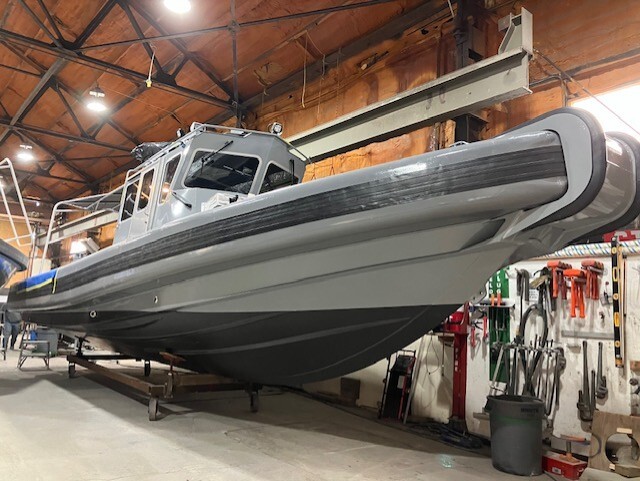
MULTIYEAR CONTRACT
MetalCraft Marine US Inc., Watertown, N.Y., is working on a five-year, $47 million contract to deliver 67 of its Force Protection Small (FPS) and Force Protection Large (FPL) Interceptor BD series patrol boats to the U.S. Navy.
The FPS measures 28'x8'6", has a draft of 24", and a loaded vessel weight of 11,860 lbs. The FPL shakes out at 39'x11'11", has a draft of 23", and a loaded vessel weight of 15,944 lbs.
“The Force Protection Small and Large patrol boats are MetalCraft Marine US Inc’s fourth or fifth time building for the Force Protection program,” said Bob Clark, MetalCraft’s contracts manager. “The FP program started back in 2000 subsequent to the (USS) Cole bombing.”
(In October 2000, the USS Cole was refueling in Yemen’s Aden Harbor when suicide bombers detonated a boat filled with explosives next to the Navy ship. When the smoke cleared, 12 sailors were dead, and 39 others suffered various injuries.)
MetalCraft built FP Mediums for the Navy from 2001 to 2004. The Navy tested the first FP Smalls starting in 2016-2018. “These boats were tested at many bases worldwide and offered very pleasing creature comforts that the crews much enjoyed, such as suspension seating, bathrooms, air conditioning and diesel heaters, as well as exterior and interior decks with shock-mitigating, long-lasting flooring,” said Clark. “MetalCraft has argued that when crews have long shifts, they need heating, cooling and shock mitigation to prevent fatigue, which can result in accidents”
Clark said propulsion for these boats are a mix of Honda, Mercury, and Yamaha outboards but gave no details beyond naming the manufacturers.
Under this contract, MetalCraft has delivered 14 of 47 FPS boats and five of 20 FPL vessels to date. “The FP program is a worldwide program to provide security for ships in foreign and in-country ports,” said Clark. “Typically, two boats are stationed at each ship’s dock. They are well-armed and well-manned with two fore and aft machine gun stations.”
The FP program large is used for ports that are not well protected from sea swell, where a larger platform can handle the sea state motion better than a small platform. The FP program large has four-gun stations. “In both size boats the cabins are identical for configuration management and crew training purposes,” said Clark.

